Category: Archives
Break the Art Fair
Jerry Saltz at New York Magazine:
 As a system, art fairs are like America: They’re broken and no one knows how to fix them. Like America, they also benefit those at the very top more than anyone else, and this gap is only growing. Like America, the art world is preoccupied by spectacle — which means nonstop art fairs, biennials, and other blowouts. Yet the place where new art comes from, where it is seen for free and where almost all the risk and innovation takes place — medium and smaller galleries – are ever pressured by rising art fair costs, shrinking attendance and business at the gallery itself, rents, and overhead. This art-fair industrial complex makes it next to impossible for any medium/small gallery to take a chance on bringing unknown or lower-priced artists to art fairs without risking major financial losses. Meanwhile high-end galleries clean up without showing much, if anything, that’s risky or innovative.
As a system, art fairs are like America: They’re broken and no one knows how to fix them. Like America, they also benefit those at the very top more than anyone else, and this gap is only growing. Like America, the art world is preoccupied by spectacle — which means nonstop art fairs, biennials, and other blowouts. Yet the place where new art comes from, where it is seen for free and where almost all the risk and innovation takes place — medium and smaller galleries – are ever pressured by rising art fair costs, shrinking attendance and business at the gallery itself, rents, and overhead. This art-fair industrial complex makes it next to impossible for any medium/small gallery to take a chance on bringing unknown or lower-priced artists to art fairs without risking major financial losses. Meanwhile high-end galleries clean up without showing much, if anything, that’s risky or innovative.
more here.
‘Come Sunday’ Considers The Price of Self-Doubt
Kelly J. Baker at The Baffler:
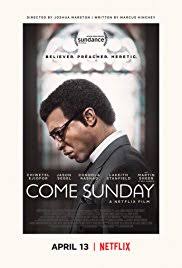 COME SUNDAY, A FILM RELEASED last month by Netflix and a production of NPR’s This American Life, claims in its short description to concern a “crisis of faith.” It’s based on the true story of Bishop Carlton Pearson, a black Pentecostal minister, and his radical shift in theology from fear, damnation, and a fallen world to forgiveness, inclusion, and hope. It’s an intriguing premise for a film, especially in this moment where pundits consider over and over why white evangelicals continue to support President Trump despite his moral bankruptcy. Politics, it would seem, matter more than faith. Toeing the party line becomes a virtue, and questioning one’s political allegiances and theology seems almost unimaginable. And yet, this intense, intimate, and quiet film—starring powerhouse actors like Chiwetel Ejiofor, Danny Glover, and Martin Sheen—centers on a moral crisis and catalogs the angst of uncertainty for a man that always appeared certain.
COME SUNDAY, A FILM RELEASED last month by Netflix and a production of NPR’s This American Life, claims in its short description to concern a “crisis of faith.” It’s based on the true story of Bishop Carlton Pearson, a black Pentecostal minister, and his radical shift in theology from fear, damnation, and a fallen world to forgiveness, inclusion, and hope. It’s an intriguing premise for a film, especially in this moment where pundits consider over and over why white evangelicals continue to support President Trump despite his moral bankruptcy. Politics, it would seem, matter more than faith. Toeing the party line becomes a virtue, and questioning one’s political allegiances and theology seems almost unimaginable. And yet, this intense, intimate, and quiet film—starring powerhouse actors like Chiwetel Ejiofor, Danny Glover, and Martin Sheen—centers on a moral crisis and catalogs the angst of uncertainty for a man that always appeared certain.
more here.
Jordan Peterson’s failed antidote for ‘toxic masculine despair’
Kate Manne at the TLS:
 Each of the ensuing chapters of 12 Rules is a series of meditations – or, less kindly, digressions – leading up to its titular rule, presented as the solution to a problem revealed therein about life and how to make order out of chaos. The chaos is in turn presented as a universal, ahistorical fact about the nature of Being or human existence. Given all this, it is striking how many of the discussions reduce to advice about how to win at something, anything, nothing in particular: and how not to be a “loser”, in relation to others whose similarity to oneself is secured by the time-honoured narrative device of anthropomorphization, under a more or less thin veneer of scientism. Rule One is “Stand up straight with your shoulders back”, to avoid seeming like a “loser lobster”, who shrinks from conflict and grows sad, sickly and loveless – and is prone to keep on losing, which is portrayed as a disaster.
Each of the ensuing chapters of 12 Rules is a series of meditations – or, less kindly, digressions – leading up to its titular rule, presented as the solution to a problem revealed therein about life and how to make order out of chaos. The chaos is in turn presented as a universal, ahistorical fact about the nature of Being or human existence. Given all this, it is striking how many of the discussions reduce to advice about how to win at something, anything, nothing in particular: and how not to be a “loser”, in relation to others whose similarity to oneself is secured by the time-honoured narrative device of anthropomorphization, under a more or less thin veneer of scientism. Rule One is “Stand up straight with your shoulders back”, to avoid seeming like a “loser lobster”, who shrinks from conflict and grows sad, sickly and loveless – and is prone to keep on losing, which is portrayed as a disaster.
more here.
That Dinosaur-Killing Asteroid? It Triggered Global Warming, Too
Robinson Meyer in The Atlantic:
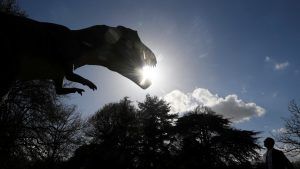
It took, at most, several seconds. An enormous hunk of rock, roughly the size of Manhattan, came whirling out of the vastness of space. It pierced Earth’s thin atmosphere, ignited as it fell, and slammed into the crust, opening a crater 20 miles deep in modern-day Mexico’s Yucatan Peninsula. Of course, it killed the non-avian dinosaurs: How could it not? By its end, the cataclysm wiped out 75 percent of all species that dwelled on Earth. In the last quarter century, we have gotten used to seeing images of that catastrophe: of the hellfire that rained down to Earth, igniting massive forest fires; of the years-long “impact winter” that dimmed the sun and chilled the Earth. But less well-known is what followed that winter. Scientists believe that the asteroid, which struck Earth roughly 66 million years ago, eventually triggered a lengthy period of ferocious global warming. Upon impact, it vaporized solid limestone into gas, and it incinerated enormous swaths of forest. This unleashed so much heat-trapping carbon dioxide into the atmosphere so quickly that, across all of Earth’s history, its rate of increase seems to be rivaled only by recent carbon pollution from factories, cars, planes, and modern industry.
A study published Thursday in Science finds new evidence of that warming while setting it in a dreadful context. It may have taken seconds for the asteroid to chew a 20-mile-deep hole in Earth. But, its authors say, it took roughly 100,000 years for Earth’s climate to return to normal. The research argues that Earth’s average temperature was elevated by 5 degrees Celsius for the 100 millennia that followed the impact. Notably, it supports this assertion not just with computer models, but with direct, observed evidence from the time period. By analyzing the bones of fish that lived in modern-day Tunisia before, during, and after the impact, scientists were able to detect a planet-sweltering warming signal.
More here.
The two faces of Philip Roth
Mark Lawson in New Statesman:
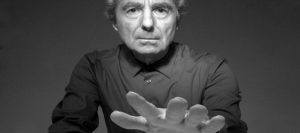 The brutal truth of literary careers is that the reputation of most great writers would not have been affected – and might even have been improved – by earlier death. Philip Roth, though, is a very rare example of a front-rank author whose later work is also the greater work. If the obituaries of Roth had appeared in the mid-Eighties of the last century rather than his own mid-80s this week, then he would likely have been remembered as a writer whose best efforts had been, in two senses, devoted to self-exploration. That early oeuvre might easily have been dismissed as penis-waving – the masturbatory comic classic, Portnoy’s Complaint(1969) – giving way to navel-gazing, in the quartet of stories – from The Ghost Writer (1979) to The Prague Orgy (1985) – that playfully dramatised, via a fictional Jewish American novelist called Nathan Zuckerman, the deranging fame and accusations of anti-semitism that resulted from the novel about the furiously self-abusing young Jew, Alexander Portnoy, or, as he became in Zuckerman’s surrogate version, Carnovsky.
The brutal truth of literary careers is that the reputation of most great writers would not have been affected – and might even have been improved – by earlier death. Philip Roth, though, is a very rare example of a front-rank author whose later work is also the greater work. If the obituaries of Roth had appeared in the mid-Eighties of the last century rather than his own mid-80s this week, then he would likely have been remembered as a writer whose best efforts had been, in two senses, devoted to self-exploration. That early oeuvre might easily have been dismissed as penis-waving – the masturbatory comic classic, Portnoy’s Complaint(1969) – giving way to navel-gazing, in the quartet of stories – from The Ghost Writer (1979) to The Prague Orgy (1985) – that playfully dramatised, via a fictional Jewish American novelist called Nathan Zuckerman, the deranging fame and accusations of anti-semitism that resulted from the novel about the furiously self-abusing young Jew, Alexander Portnoy, or, as he became in Zuckerman’s surrogate version, Carnovsky.
But, in 1986, Roth began perhaps the most remarkable and redefining second and third acts of any writing life. The Counterlife, the fifth Zuckerman book, remained playful (characters can joltingly be alive, dead, then living again) but moved beyond the narrow focus of literary celebrity to tackle the Jewish experience in England, the Middle East and history. Two skilful memoirs – The Facts (1988) and Patrimony (1991) – also usefully established the extent to which the Zuckerman sequence, assumed to be autobiographical, was invented.
More here.
Friday Poem
Sedition — a letter to the writer from Meri Mangakāhia
Here’s what I had in mind, kōtiro, this
clipping at words like overgrown maikuku —
return the blankets of domestic life; don’t fold
washing or wear shoes, polish these rerenga kē.
.
Eh. But this world.
I s’pose neither of us planned to be in politics,
never did do what others told us to —
wahanui though, go on, get
.
your sedition on girl,
your agitator, your defiant speak
to each other eye to eye —
Māori been jailed for nouns, phrases;
.
butcher up a clause, get buried
in Pākehā kupu, then dig that
out like the old people. No one approved
of their language either.
..
..
by Anahera Gildea
Source: Poetry (February 2018)
Thursday, May 24, 2018
The Fundamental Nihilism of Yanny VS. Laurel
Adam Rogers in Wired:
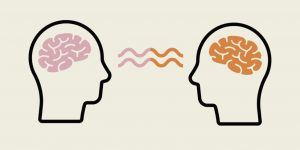 Some people heard the word “laurel” in a short audio clip that became internet-famous this week, while others heard the not-word “yanny.” This proves that we will all die alone.
Some people heard the word “laurel” in a short audio clip that became internet-famous this week, while others heard the not-word “yanny.” This proves that we will all die alone.
Thanks to some sleuthing by my colleague Louise Matsakis, people interested in following up can learn that regardless of what they heard in the clip, the person speaking was, in fact, saying the word “laurel.” But the question of what was recorded, for real, diverges in important ways from the question of what people heard, also for real.
Let me put this another way: Three years back, a picture of a dress—The Dress—became internet famous, because some people saw it as blue and others saw it as white. The question of why sent scientists who study color vision into a flurry of activity that’s still going on today. They want to better understand how the brain factors in illumination when calculating the color of an object, and how people see yellowish colors differently than bluish ones. Again, none of that work asks what color The Dress actually was, for real. (Blue.)
There is a world that exists—an uncountable number of differently-flavored quarks bouncing up against each other. There is a world that we perceive—a hallucination generated by about a pound and a half of electrified meat encased by our skulls. Connecting the two, or conveying accurately our own personal hallucination to someone else, is the central problem of being human. Everyone’s brain makes a little world out of sensory input, and everyone’s world is just a little bit different.
More here.
Benedict Cumberbatch Meets Albert Einstein in Carlo Rovelli’s New Audiobook
Alan Lightman in the New York Times:
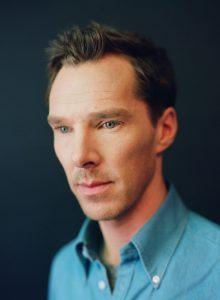 There’s a passage in Carlo Rovelli’s lovely new book, “The Order of Time” — a letter from Einstein to the family of his recently deceased friend Michele Besso: “Now he has departed from this strange world a little ahead of me. That means nothing… The distinction between past, present and future is only a stubbornly persistent illusion.” Rovelli comments that Einstein was taking great poetic license with the temporal findings of his relativity theory, even to the point of error. But then the author goes on to say that the great physicist was addressing his letter not to scientists or philosophers, but to a bereft family. “It’s a letter written to console a grieving sister,” he writes. “A gentle letter, alluding to the spiritual bond between Michele and Albert.” That sensitivity to the human condition is a constant presence in Rovelli’s book — a book that reviews all of the best scientific thinking about the perennial mystery of time, from relativity to quantum physics to the inexorable second law of thermodynamics. Meanwhile, he always returns to us frail human beings — we who struggle to understand not only the external world of atoms and galaxies but also the internal world of our hearts and our minds.
There’s a passage in Carlo Rovelli’s lovely new book, “The Order of Time” — a letter from Einstein to the family of his recently deceased friend Michele Besso: “Now he has departed from this strange world a little ahead of me. That means nothing… The distinction between past, present and future is only a stubbornly persistent illusion.” Rovelli comments that Einstein was taking great poetic license with the temporal findings of his relativity theory, even to the point of error. But then the author goes on to say that the great physicist was addressing his letter not to scientists or philosophers, but to a bereft family. “It’s a letter written to console a grieving sister,” he writes. “A gentle letter, alluding to the spiritual bond between Michele and Albert.” That sensitivity to the human condition is a constant presence in Rovelli’s book — a book that reviews all of the best scientific thinking about the perennial mystery of time, from relativity to quantum physics to the inexorable second law of thermodynamics. Meanwhile, he always returns to us frail human beings — we who struggle to understand not only the external world of atoms and galaxies but also the internal world of our hearts and our minds.
More here.
The Meaning and Legacy of Humanism: A Sharp Challenge from a Potential Ally: Yuval Noah Harari and A. P. Norman
From Secular Humanism:
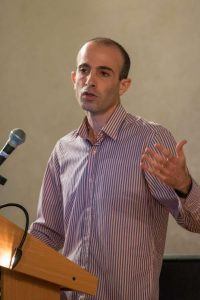 In 2015, Israeli historian Yuval Noah Harari published Sapiens, a sweeping and widely acclaimed history of humankind. In it, he discusses a phenomenon he calls “humanism.” Humanism, as he defines it, is a family of “religions (that) worship humanity, or more correctly, homo sapiens.” This worship of humanity, he argues, has made modernity “an age of intense religious fervor, unparalleled missionary efforts, and the bloodiest wars of religion in history.” The crimes of genocidal Nazism, Stalinist communism, and environmental destruction, he argues, can all be traced to the central tenets of humanism. If Harari is right, humanists need to engage in some serious soul-searching.
In 2015, Israeli historian Yuval Noah Harari published Sapiens, a sweeping and widely acclaimed history of humankind. In it, he discusses a phenomenon he calls “humanism.” Humanism, as he defines it, is a family of “religions (that) worship humanity, or more correctly, homo sapiens.” This worship of humanity, he argues, has made modernity “an age of intense religious fervor, unparalleled missionary efforts, and the bloodiest wars of religion in history.” The crimes of genocidal Nazism, Stalinist communism, and environmental destruction, he argues, can all be traced to the central tenets of humanism. If Harari is right, humanists need to engage in some serious soul-searching.
In mid-2017, Tom Flynn, editor of this magazine, responded with an editorial arguing that Harari’s “extreme and factually untethered” critique effectively “smears” humanism (“Smearing Humanism,” FI, June/July 2017). A. P. (Andy) Norman, a humanist philosopher and frequent contributor to Free Inquiry, shared Flynn’s concerns but found that he was able to view Harari’s efforts in a more charitable light. For if you grant Harari his definition of humanism, much of the rest seems to follow. Moreover, the resulting story—a kind of revisionist take on modernity—does contain important insights. Nevertheless, Norman reached out to Harari with a plea to rethink and rescind his critique of humanism. Harari replied, and the ensuing exchange is presented here, with only minor edits. The issue, it turns out, has profound implications for the humanist movement and its historical legacy.
More here.
The sound that connects Stravinsky to Bruno Mars
On the Music of Ulysses and Finnegans Wake
Gerri Kimber at the TLS:
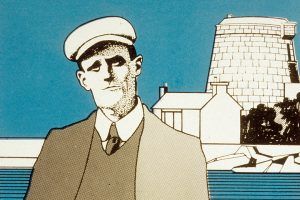 By the time he came to write Finnegans Wake, Joyce had moved beyond trying to imitate musical forms, and described his novel not as a “blending of literature and music”, but rather as “pure music”. Writing to his daughter Lucia, Joyce explained, “Lord knows what my prose means. In a word, it is pleasing to the ear . . . . That is enough, it seems to me”, and in conversation, he declared, “judging from modern trends it seems that all the arts are tending towards the abstraction of music; and what I am writing at present is entirely governed by that purpose”. This offers perhaps the best way to approach his most complex work. Joyce emphasizes how, “if anyone doesn’t understand a passage, all he need do is read it aloud”, and such an approach certainly helps here: “and the rhymers’ world was with reason the richer for a wouldbe ballad, to the balledder of which the world of cumannity singing owes a tribute for having placed on the planet’s melomap his lay of the vilest bogeyer but most attractionable avatar the world has ever had to explain for”.
By the time he came to write Finnegans Wake, Joyce had moved beyond trying to imitate musical forms, and described his novel not as a “blending of literature and music”, but rather as “pure music”. Writing to his daughter Lucia, Joyce explained, “Lord knows what my prose means. In a word, it is pleasing to the ear . . . . That is enough, it seems to me”, and in conversation, he declared, “judging from modern trends it seems that all the arts are tending towards the abstraction of music; and what I am writing at present is entirely governed by that purpose”. This offers perhaps the best way to approach his most complex work. Joyce emphasizes how, “if anyone doesn’t understand a passage, all he need do is read it aloud”, and such an approach certainly helps here: “and the rhymers’ world was with reason the richer for a wouldbe ballad, to the balledder of which the world of cumannity singing owes a tribute for having placed on the planet’s melomap his lay of the vilest bogeyer but most attractionable avatar the world has ever had to explain for”.
more here.
Hunting for a Lesbian Canon
Yelena Moskovich at The Paris Review:
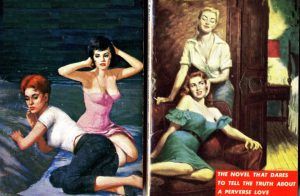 Another early lesbian-pulp and layered reading experience is Spring Fire (1952), by Vin Packer (one of the pseudonyms of the prolific author Marijane Meaker). Although its seemingly naive Americana tone reads today as camp, the novel plays with semantics and morality in its own way. Within this supposed “steamy page-turner … once told in whispers” is the tale of a newbie Midwestern student named Susan Mitchell. (She goes by—you guessed it—Mitch.) Mitch is seduced by her sorority sister, the come-hither green-eyed Leda, when she asks Mitch to give her a back rub and then suddenly “rolled over and lay with her breasts pushed up toward Mitch’s hands.” Although the prose at first rings as high-strung, it echoes with complex undertones. “There are a lot of people who love both [men and women] and no one gives a damn, and they just say you’re oversexed,” Leda explains to Mitch. “But they start getting interested when you stick to one sex. Like you’ve been doing, Mitch. I couldn’t love you if you were a Lesbian.” (Note the capital l.)
Another early lesbian-pulp and layered reading experience is Spring Fire (1952), by Vin Packer (one of the pseudonyms of the prolific author Marijane Meaker). Although its seemingly naive Americana tone reads today as camp, the novel plays with semantics and morality in its own way. Within this supposed “steamy page-turner … once told in whispers” is the tale of a newbie Midwestern student named Susan Mitchell. (She goes by—you guessed it—Mitch.) Mitch is seduced by her sorority sister, the come-hither green-eyed Leda, when she asks Mitch to give her a back rub and then suddenly “rolled over and lay with her breasts pushed up toward Mitch’s hands.” Although the prose at first rings as high-strung, it echoes with complex undertones. “There are a lot of people who love both [men and women] and no one gives a damn, and they just say you’re oversexed,” Leda explains to Mitch. “But they start getting interested when you stick to one sex. Like you’ve been doing, Mitch. I couldn’t love you if you were a Lesbian.” (Note the capital l.)
more here.
The Fearless Cinema of Claire Denis
Alice Gregory at The New Yorker:
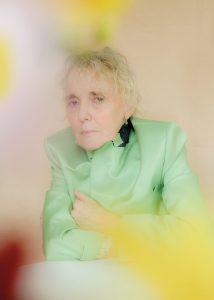 Denis’s films are filled with lush scenes of the natural world—African deserts, snowy Alpine fields, and the mineral-green waters of the South Pacific—and characters who tend to reveal themselves not through dialogue but through how they move and look. Alex Descas, one of the actors with whom Denis has worked longest, and who credits her with writing complicated, realistic roles for black actors at a time when few others did, described her artistic mode succinctly: “Film is not theatre,” he told me. Last month, at a screening of her latest movie, “Let the Sunshine In,” at the IFC Center, in Manhattan, Denis said, “I once read that I like to film bodies. No! But, if you choose someone, that person hasa body. They have feet, hands, hair, breasts, ass—all of that is part of what is important.” The film stars Juliette Binoche, as a divorced painter who dates men she shouldn’t: a married banker, a narcissistic actor, a standoffish curator. “She wanted my character to be beautiful and desirable and luminous,” Binoche told me. In the final shot, the camera—which one critic described as “smitten”—stays on her smiling face, which is ablaze with delusion and hope. Denis, according to Binoche, “works like a portrait painter.”
Denis’s films are filled with lush scenes of the natural world—African deserts, snowy Alpine fields, and the mineral-green waters of the South Pacific—and characters who tend to reveal themselves not through dialogue but through how they move and look. Alex Descas, one of the actors with whom Denis has worked longest, and who credits her with writing complicated, realistic roles for black actors at a time when few others did, described her artistic mode succinctly: “Film is not theatre,” he told me. Last month, at a screening of her latest movie, “Let the Sunshine In,” at the IFC Center, in Manhattan, Denis said, “I once read that I like to film bodies. No! But, if you choose someone, that person hasa body. They have feet, hands, hair, breasts, ass—all of that is part of what is important.” The film stars Juliette Binoche, as a divorced painter who dates men she shouldn’t: a married banker, a narcissistic actor, a standoffish curator. “She wanted my character to be beautiful and desirable and luminous,” Binoche told me. In the final shot, the camera—which one critic described as “smitten”—stays on her smiling face, which is ablaze with delusion and hope. Denis, according to Binoche, “works like a portrait painter.”
more here.
Thursday Poem
Sign Language
For the man who jumped out in front of the woman with his
arm raised like a machete screaming Abomination! as she
walked the streets of San Francisco holding her lover’s hand
for the first time in public.
There is a woman who goes to sleep
every night wishing she had broken
your sternum reached up inside your
chest momentarily borrowing your
heart to hold before your screaming
face and with her other hand still
clutching her lover’s broke next into
her own sternum plucking next her
own heart dangling them both there
sterling silver sign language for you
tell me what is the difference.
by Nikki Finney
from The World is Round
Innerlight Publishing, 2003
How to make a city waterproof
Giovanna Dunmall in The Economist:
 One evening in March, a pale-blue layer of light began spreading across the plaza outside the United Nations headquarters in New York. Emanating from banks of leds, it appeared to undulate like the surface of the sea high above the heads of passing pedestrians. The effect may have been ethereal but the warning was all too real: the light submerged the plaza to the same depth that water may do if nothing is done to control rising sea levels. Called “Waterlicht” (Waterlight), the installation was the work of Daan Roosegaarde, a Dutch artist; New York was just one stop on a tour of global cities. Roosegaarde’s intention is to focus people’s minds on the prospect of a watery future. “Above all it gets people who might never do so talking about water and global warming,” he says. Often the conversation turns to keeping water out. But increasingly urban planners and designers are taking their cues from Rotterdam, the city where Roosegaarde lives and works: they are working out how to let water in. Like thousands of coastal cities from Shanghai to Miami, Osaka to New York, Rotterdam is under threat. More than 80% of this port on the Netherlands’ North Sea coast lies below sea level, the ocean kept at bay by a sophisticated system of levees, dykes, dams and storm-surge barriers known as the Delta Works. But by the end of the century those sea levels are predicted to rise by around a metre and the Netherlands is already seeing an increase in rainfall and flooding. To make matters worse, the thousands of pumps that remove groundwater up and down the country are causing the peat to dehydrate and the ground to sink. In recent years this has led to a shift in thinking: instead of working against the water, why not re-engineer the city to work with it?
One evening in March, a pale-blue layer of light began spreading across the plaza outside the United Nations headquarters in New York. Emanating from banks of leds, it appeared to undulate like the surface of the sea high above the heads of passing pedestrians. The effect may have been ethereal but the warning was all too real: the light submerged the plaza to the same depth that water may do if nothing is done to control rising sea levels. Called “Waterlicht” (Waterlight), the installation was the work of Daan Roosegaarde, a Dutch artist; New York was just one stop on a tour of global cities. Roosegaarde’s intention is to focus people’s minds on the prospect of a watery future. “Above all it gets people who might never do so talking about water and global warming,” he says. Often the conversation turns to keeping water out. But increasingly urban planners and designers are taking their cues from Rotterdam, the city where Roosegaarde lives and works: they are working out how to let water in. Like thousands of coastal cities from Shanghai to Miami, Osaka to New York, Rotterdam is under threat. More than 80% of this port on the Netherlands’ North Sea coast lies below sea level, the ocean kept at bay by a sophisticated system of levees, dykes, dams and storm-surge barriers known as the Delta Works. But by the end of the century those sea levels are predicted to rise by around a metre and the Netherlands is already seeing an increase in rainfall and flooding. To make matters worse, the thousands of pumps that remove groundwater up and down the country are causing the peat to dehydrate and the ground to sink. In recent years this has led to a shift in thinking: instead of working against the water, why not re-engineer the city to work with it?
At first glance, Rotterdam’s Benthemplein (below) looks like a pleasant but ordinary city square. It has a basketball court, skateboarding ramps and benches. Look a little closer, however, and you begin to notice an array of wide, stainless-steel gutters zig-zagging around it; striking green, white and blue water-themed patterns on the ground; and two shallow basins that appear to feed into the basketball court, which is surrounded by stepped seating. Benthemplein is actually one of five water plazas in Rotterdam and was designed by De Urbanisten, an architecture firm based in the city. A receptacle for up to 1.7m litres of excess water, it funnels the flow from surrounding streets and rooftops. When heavy rain comes the two smaller basins fill up before feeding a third, deeper one, their contents gushing over a beautiful “water wall”. In dry weather the square, which is also planted with tall grasses and shrubs, is a buzzing hub. In wet weather it becomes an inner-city lake.
More here.
Philip Roth, a Writer All the Way Down
Zadie Smith in The New Yorker:
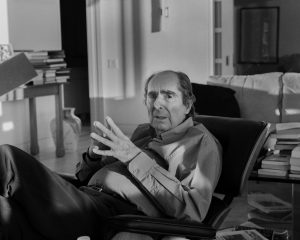 One time, I was having a conversation with Philip Roth about lane swimming, a thing it turned out we both liked to do, although he could swim much farther and much faster. He asked me, “What do you think about as you do each length?” I told him the dull truth. “I think, first length, first length, first length, and then second length, second length, second length. And so on.” That made him laugh. “You wanna know what I think about?” I did. “I choose a year. Say, 1953. Then I think about what happened in my life or within my little circle in that year. Then I move on to thinking about what happened in Newark, or New York. Then in America. And then if I’m going the distance I might start thinking about Europe, too. And so on.” That made me laugh. The energy, the reach, the precision, the breadth, the curiosity, the will, the intelligence. Roth in the swimming pool was no different than Roth at his standing desk. He was a writer all the way down. It was not diluted with other things as it is—mercifully!—for the rest of us. He was writing taken neat, and everything he did was at the service of writing. At an unusually tender age, he learned not to write to make people think well of him, nor to display to others, through fiction, the right sort of ideas, so they could think him the right sort of person. “Literature isn’t a moral beauty contest,” he once said. For Roth, literature was not a tool of any description. It was the venerated thing in itself. He loved fiction and (unlike so many half or three-quarter writers) was never ashamed of it. He loved it in its irresponsibility, in its comedy, in its vulgarity, and its divine independence. He never confused it with other things made of words, like statements of social justice or personal rectitude, journalism or political speeches, all of which are vital and necessary for lives we live outside of fiction, but none of which are fiction, which is a medium that must always allow itself, as those other forms often can’t, the possibility of expressing intimate and inconvenient truths.
One time, I was having a conversation with Philip Roth about lane swimming, a thing it turned out we both liked to do, although he could swim much farther and much faster. He asked me, “What do you think about as you do each length?” I told him the dull truth. “I think, first length, first length, first length, and then second length, second length, second length. And so on.” That made him laugh. “You wanna know what I think about?” I did. “I choose a year. Say, 1953. Then I think about what happened in my life or within my little circle in that year. Then I move on to thinking about what happened in Newark, or New York. Then in America. And then if I’m going the distance I might start thinking about Europe, too. And so on.” That made me laugh. The energy, the reach, the precision, the breadth, the curiosity, the will, the intelligence. Roth in the swimming pool was no different than Roth at his standing desk. He was a writer all the way down. It was not diluted with other things as it is—mercifully!—for the rest of us. He was writing taken neat, and everything he did was at the service of writing. At an unusually tender age, he learned not to write to make people think well of him, nor to display to others, through fiction, the right sort of ideas, so they could think him the right sort of person. “Literature isn’t a moral beauty contest,” he once said. For Roth, literature was not a tool of any description. It was the venerated thing in itself. He loved fiction and (unlike so many half or three-quarter writers) was never ashamed of it. He loved it in its irresponsibility, in its comedy, in its vulgarity, and its divine independence. He never confused it with other things made of words, like statements of social justice or personal rectitude, journalism or political speeches, all of which are vital and necessary for lives we live outside of fiction, but none of which are fiction, which is a medium that must always allow itself, as those other forms often can’t, the possibility of expressing intimate and inconvenient truths.
Roth always told the truth—his own, subjective truth—through language and through lies, the twin engines at the embarrassing heart of literature. Embarrassing to others, never to Roth. Second selves, fake selves, fantasy selves, replacement selves, horrifying selves, hilarious, mortifying selves—he welcomed them all. Like all writers, there were things and ideas that lay beyond his ken or conception; he had blind spots, prejudices, selves he could imagine only partially, or selves he mistook or mislaid. But, unlike many writers, he did not aspire to perfect vision. He knew that to be an impossibility. Subjectivity is limited by the vision of the subject, and the task of writing is to do the best with what you have. Roth used every little scrap of what he had. Nothing was held back or protected from writing, nothing saved for a rainy day. He wrote every single book he intended to write and said every last thing he meant to say. For a writer, there is no greater aspiration than that. To swim all eighty-five lengths of the pool and then get out without looking back.
More here.
Wednesday, May 23, 2018
How a Pioneer of Machine Learning Became One of Its Sharpest Critics
Kevin Hartnett in The Atlantic:
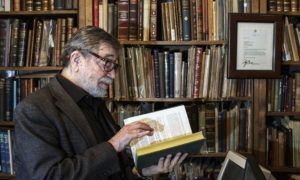 Artificial intelligence owes a lot of its smarts to Judea Pearl. In the 1980s he led efforts that allowed machines to reason probabilistically. Now he’s one of the field’s sharpest critics. In his latest book, The Book of Why: The New Science of Cause and Effect, he argues that artificial intelligence has been handicapped by an incomplete understanding of what intelligence really is.
Artificial intelligence owes a lot of its smarts to Judea Pearl. In the 1980s he led efforts that allowed machines to reason probabilistically. Now he’s one of the field’s sharpest critics. In his latest book, The Book of Why: The New Science of Cause and Effect, he argues that artificial intelligence has been handicapped by an incomplete understanding of what intelligence really is.
Three decades ago, a prime challenge in artificial-intelligence research was to program machines to associate a potential cause to a set of observable conditions. Pearl figured out how to do that using a scheme called Bayesian networks. Bayesian networks made it practical for machines to say that, given a patient who returned from Africa with a fever and body aches, the most likely explanation was malaria. In 2011 Pearl won the Turing Award, computer science’s highest honor, in large part for this work.
But as Pearl sees it, the field of AI got mired in probabilistic associations.
More here.
How I learned to stop caring about prestige
Edmond Sanganyado in Science:
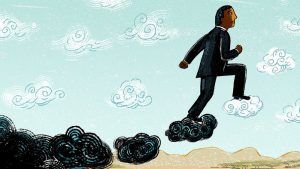 I leapt into the air, screaming at the top of my lungs with tears rolling down my cheeks as the news sank in. I had lost both of my parents when I was 16 years old, and I had often been sent home from school for unpaid tuition as I worked my way to a bachelor’s degree in my home country of Zimbabwe. But now, I was a Fulbright fellow. I was convinced that the award would propel my career to unconceivable heights. It was all the sweeter when I thought of my mother and how she used to cry over my report cards. At the time, I thought it was because I had not done well enough, but I later realized she was crying because she could not bear the idea that her poverty would keep me from reaching my full potential. I carried the burden of wanting to do her proud, and the fellowship was a huge step in that direction. It would also help me prove to the world that I was more than my family’s poverty. The numerous first-time opportunities the fellowship afforded—flying on a plane, staying in a hotel, moving to the United States—earned me respect in my small farming town. The chance to study and work abroad raised my own expectations sky-high as well.
I leapt into the air, screaming at the top of my lungs with tears rolling down my cheeks as the news sank in. I had lost both of my parents when I was 16 years old, and I had often been sent home from school for unpaid tuition as I worked my way to a bachelor’s degree in my home country of Zimbabwe. But now, I was a Fulbright fellow. I was convinced that the award would propel my career to unconceivable heights. It was all the sweeter when I thought of my mother and how she used to cry over my report cards. At the time, I thought it was because I had not done well enough, but I later realized she was crying because she could not bear the idea that her poverty would keep me from reaching my full potential. I carried the burden of wanting to do her proud, and the fellowship was a huge step in that direction. It would also help me prove to the world that I was more than my family’s poverty. The numerous first-time opportunities the fellowship afforded—flying on a plane, staying in a hotel, moving to the United States—earned me respect in my small farming town. The chance to study and work abroad raised my own expectations sky-high as well.
But as I completed my Ph.D. about 5 years later, it became clear that, even with a Fulbright fellowship, I would not achieve all I had dreamed of. A degree from a solid but not world-renowned university and publications in journals with middling impact factors were not enough to secure the prestigious postdoc I thought I needed to achieve my long-term goals: opening my own lab and securing tenure. So, on 4 July 2016, while the rest of America celebrated its independence, I took a flight back to Zimbabwe—jobless, dejected, and hopeless. Back home, people respected me. A bank teller insisted on putting “Dr.” on my ATM card. At community gatherings, elderly people offered me their seats when they learned I had a Ph.D. Yet, as I continued to unsuccessfully pursue a postdoc at a top-notch institution, I was haunted by the feeling that I was a failure.
More here.
Wednesday Poem
At the Museum
But in 2500 B.C. Harappa,
who cast in bronze a servant girl?
No one keeps records
of soldiers and slaves.
The sculptor knew this,
polishing the ache
off her fingers stiff
from washing the walls
and scrubbing the floors,
from stirring the meat
and the crushed asafoetida
in the bitter gourd.
But I’m grateful she smiled
at the sculptor,
as she smiles at me
in bronze,
a child who had to play woman
to her lord
when the warm June rains
came to Harappa.
by Agha Shahid Ali
from Poetry, 1990
